On the Double
Welcome to my second Double Masters preview week. Last week, I talked about the design of the set. This week I decided to share some stories about how cards in the set were originally designed. (I did a similar article for Core Set 2021 that got a very positive response, so I thought I'd do it again.) Also, before my article is done, I'll share two new preview cards for Double Masters. That said, on with the stories.
Fetid Heath, Cascade Bluffs, Rugged Prairie, Twilight Mire, and Flooded Grove
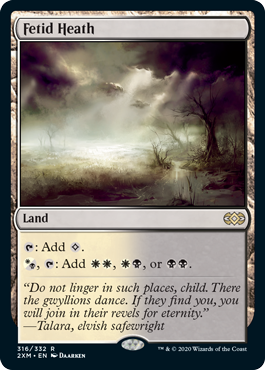
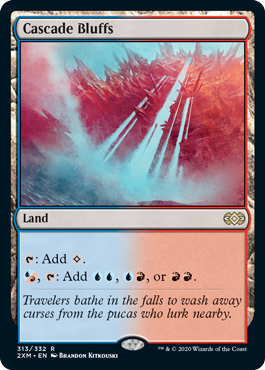
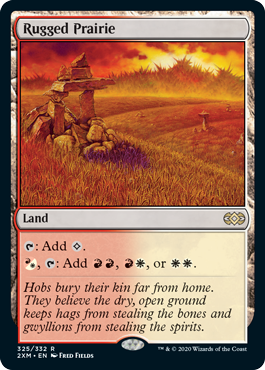
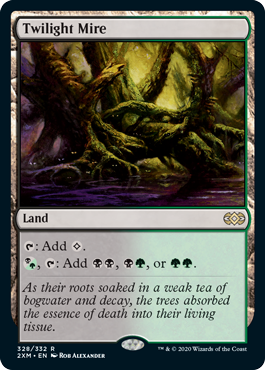

This story starts back in Future Sight. Each of the sets in the Time Spiral block had what we called a timeshifted sheet which was a group of cards that had a different frame than the main set and hit the theme of the set in an interesting way. Time Spiral's timeshifted sheet had cards from the past in the original card frame. Planar Chaos had cards from an alternate present where each card was a color-shifted version of an existing Magic card on an alternate frame. Future Sight had the wildest timeshifted sheet. It was going to have futureshifted cards which were Magic cards from potential futures of the game on a future frame.
I really wanted to have dual lands on the futureshifted sheet, so I set out to make a cycle. I ran into an interesting problem. If I made a full cycle of them, it just felt like I made a dual land cycle like I would in any set. It didn't feel futureshifted in any way. That's when I came up with an interesting idea. What if each dual land in my cycle was from a different potential future dual land cycle? It would be a cycle of cycles.
The plan with all the futureshifted cards was that we'd check back when making future sets and use the cards when appropriate. About a year later, I was designing Shadowmoor when I realized that one of the cards from my dual land cycle of cycles would work in the set. Graven Cairns was a perfect fit for a hybrid-focused expansion. We took it and made the four other allied dual lands to go with it. When we made Eventide, we made the enemy versions of those duals.
Karn Liberated
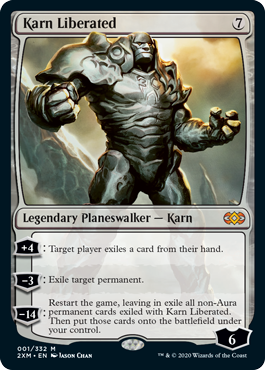
This story starts back in 1996. Michael Ryan and I were putting together a story to pitch to the Magic brand team to convince them to start a Magic story that would get woven into the sets. (This would become the Weatherlight Saga.) To do that, we had to make a cast of characters. It was important to us to make characters that covered the entire color pie. One of the things that meant was we needed an artifact creature. I was partial to a Golem, so I convinced Michael to make him one. Michael and I liked the idea that he would fit the "gentle giant" archetype, someone that looked like they could be threatening but were in fact very sweet on the inside.
During Tempest, to help create a singular voice and feel for each character in flavor text, we divvied up characters by writer. I ended up with Karn (and Ertai), meaning that for the first year, I wrote all of Karn's flavor text. While I liked all the characters Michael and I made, I always had a soft spot for Karn.
Flash forward a number of years. We're working on the Scars of Mirrodin block. In the story, Karn gets captured by the Phyrexians (he was responsible for accidentally bringing them to Mirrodin) and things are looking pretty bad for him. I think we had started design on New Phyrexia, and I walked over to talk with Brady Dommermuth, then the creative director. We were going to have a Karn card in the set, and I was trying to get a sense of what it would look like.
Brady said to me that they were trying to figure out how the story ends. Either Karn gets totally corrupted by the Phyrexians and becomes the Father of Machines, a legendary creature, or he breaks free and gets printed as a planeswalker card. My response: "We were really hoping he could be a planeswalker card." I'm not sure how much my input swayed the story, but I had to look out for my not-so-little Golem.
I believe the design of the card itself started with the ultimate. We wanted an ultimate that really captured the flavor of Karn liberating himself from the Phyrexians. I don't remember who pitched the idea of the game restarting, but we realized when we heard it that that was the way we had to go. The other two abilities were designed to set up the ultimate. The exile of a permanent was the stronger ability and had a bigger impact on the board, so we made that the minus loyalty ability. I think we talked about the first effect being a milling effect but decided the exiling from hand was better.
Magus of the Will
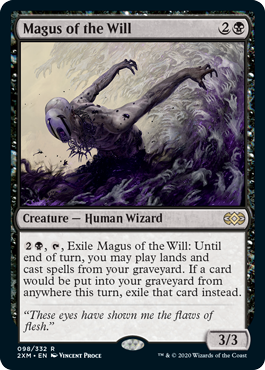
This story begins in Time Spiral design. We were very focused on nostalgic designs, so we were looking for cool ways to make new cards that harkened back to old cards. One of the ideas we came up with was to take old, popular powerful artifacts and print their abilities on creatures. The reason this was cool was threefold. One, creatures are more vulnerable than artifacts, so it would allow us to print the creatures at the same converted mana cost as the artifact (shifting one or more of the generic mana to colored). We then chose a power and toughness that worked with that mana cost. Two, this would allow us to reprint artifact effects of artifacts we couldn't reprint, such as cards on the Reserved List. Three, when you change card types, you get to create new interactions with the effects. There would be things you could do with the Maguses that you could never do with the original artifacts.
There was much time spent finding the right five artifacts to match to a cycle of creatures. As the artifacts we were referencing were all colorless, we had to match them up properly with each of the five colors. As with many cycles, the early choices were easy and then it got more difficult. I think we spent numerous hours trying to find the best choice for the black Magus. We named them so each card would give a nod to the artifact the creature was redoing.
Here are the five cards we made:
Magus of the Disk was a redo of Nevinyrral's Disk from Alpha. Magus of the Jar was a redo of Memory Jar from Urza's Legacy. Magus of the Mirror was a redo of Mirror Universe from Legends. Magus of the Scroll was a redo of Cursed Scroll from Tempest. Magus of the Candelabra was a redo of Candelabra of Tawnos from Antiquities.
We had so much fun making the Time Spiral cycle, we decided to do it again in the very next set, Planar Chaos, but instead of doing artifacts, this time we did lands. As they didn't have a mana cost, it allowed us to make each creature whatever cost and size served the effect best. Like the artifacts, we had to match up lands to each of the five colors. This time, at least, black was easy. I think green was the troublesome one this time.
Here they are:
Magus of the Tabernacle was a redo of The Tabernacle at Pendrell Vale from Legends. Magus of the Bazaar was a redo of Bazaar of Baghdad from Arabian Nights. Magus of the Coffers is a redo of Cabal Coffers from Torment. Magus of the Arena is a redo of Arena, a book promo card from way back in the day. (The first Magic novels came with a coupon in the book you could send in for a promo card.) Magus of the Library was a redo of Library of Alexandria from Arabian Nights. (I'll admit that this was an odd fit.)
Two points make a line, so it was obvious Future Sight had to finish this block cycle. We had done artifacts and lands, so that meant there was only one permanent type remaining, enchantments. (Planeswalkers would come into existence the very next set but weren't a thing yet.) Enchantments were easier in some ways and more difficult in others. For instance, they were already colored, so it was clear what color each enchantment effect belonged to, but because they already had a colored mana cost, we felt obliged to keep them exact, which added a component that we couldn't change and had to design around.
Here's what we made:
Magus of the Moat was a redo of Moat from Legends. Magus of the Future was a redo of Future Sight from Onslaught. (And yes, we enjoyed the fact that we were doing a redo of Future Sight in Future Sight.) Magus of the Abyss was a redo of The Abyss from Legends. Magus of the Moon was a redo of Blood Moon from The Dark. Magus of the Vineyard was a redo of Eladamri's Vineyard from Tempest.
And with that, we thought we were done. Three cycles of the three permanent types stretched across the three sets of the block. Take a bow.
Our story picks up again in the design of Commander 2015. Someone on the team (I wasn't on the team, so I don't know who) said, "Wait a minute, we did Maguses for all the permanent types, save planeswalker. What about the non-permanent card types?"
So, they designed this card:
Magus of the Wheel is a redo of Wheel of Fortune from Alpha. It was the redo of a sorcery. When the card was released, the players asked about the rest of the cycle. Maguses always come in cycles. Where are the white, blue, black, and green Maguses of sorceries? Each year, the Commander set would bring one more.
Magus of the Will is a redo of Yawgmoth's Will from Urza's Saga. Magus of the Mind is a redo of Mind's Desire from Scourge. Magus of the Balance is a redo of Balance from Alpha. They appeared in Commander 2016, Commander 2017, and Commander 2018, respectively. Commander 2019 was supposed to have the final card in the cycle, the green Magus, but that card got pushed off to another product, which will be explained when it finally comes out.
When the green Magus gets released, I can finally start to field the questions about when we're doing the instant Magus cycle.
Oubliette
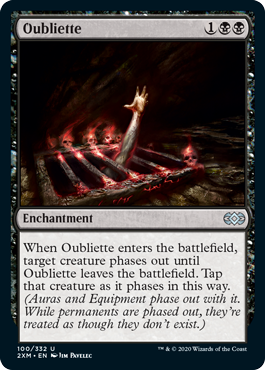
This story starts back in Arabian Nights. Richard Garfield liked the idea of a card that locked away a creature. An oubliette is a jail cell or dungeon that can only be accessed through a door in its ceiling. It was setting appropriate and seemed kind of dark, so Richard designed a top-down card and put it in black. A few years later, in Mirage, we would settle on this effect being white (called Pacifism) and went with the more simplified text of "can't attack or block." Years later, in Mercadian Masques, we would make the variant Arrest, which also stopped activated abilities. Numerous years after that, in Lorwyn, we would make Oblivion Ring, which removed the creature from the battlefield. Suffice to say, the ability didn't stay in black long.
This is important because Oubliette had the distinction of being common in Arabian Nights. That made it legal in the Pauper format. I'm not well versed on the Pauper metagame, but there was desire for the card. (My sources tell me its popular in mono-black decks with a devotion component.) The problem was that the only time the card had ever been printed was Arabian Nights. Arabian Nights had a low print run, which made the card pretty hard to find.
This resulted in a number of players asking for Oubliette to get reprinted. Okay, when we get a lot of requests for something, we look into it. There were a couple problems. First up, the card is no longer in color pie. White is the color that locks things away, black just kills them. This meant that we couldn't include it in any premier set as we like to keep Standard up to modern color pie. That's fine, we make a lot of supplemental sets, and many of them have reprints.
This brought us to our next problem. Whenever we change templates, we update all our old cards in Oracle to fit the current templating. Oubliette when templated with modern templating no longer fit on a printed card. For years, that prevented us from reprinting the card. Interestingly, our salvation was a mechanic from 1996—phasing. Using a keyword action allowed us to significantly lower the amount of text needed and print it on a card. One which you can now open in a booster of Double Masters.
Sorry, it took so long.
Treasure Mage
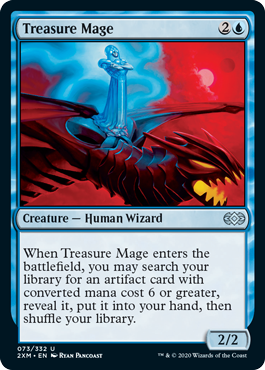
This story starts back in the design of Fifth Dawn. One of the themes we'd put into the set was something we called cogs. Cogs were artifacts that had a converted mana cost of 1 or less and had small effects. We then made a number of cards in the set which interacted with the cogs to help you build a deck around them. One such card was designed by Aaron Forsythe:
Aaron enjoys tutoring and "enters the battlefield" effects on creatures, so he combined them to make a cog-friendly Wizard. Trinket Mage got printed and has seen play in numerous formats. (Having a lot of powerful artifacts with a converted mana cost of 1 or less in older formats didn't hurt.)
Flash forward a number of years to Mirrodin Besieged. We're back on Mirrodin, so we decided to make a mirror of Trinket Mage called Treasure Mage. Instead of searching for a small artifact (one with a converted mana cost of 1 or less), it looks for a large artifact (one that has a converted mana cost of 6 or more). It was also a 2/2 for 2U, and we called it Treasure Mage to have a similar feel.
While technically the story is done on Treasure Mage's design, there's still a little more story to tell. The Aether Revolt design team made Trophy Mage, which tutors for an artifact with a converted mana cost of exactly 3. It's also a 2/2 for 2U with a T word in its name. Modern Horizons then made Tribute Mage, which tutors for an artifact with a converted mana cost of exactly 2.
All of this leaves artifacts of converted mana costs 4 or 5 unaccounted for, but I have faith that one day, provided we don't run out of T words, we'll see this—I'm not sure what to call it as "cycle" seems a little off—completed.
Preview from Above
Before we wrap up for today, I have some preview cards to show you.
To make the reveal extra fun, I'm going to give you three clues about each one. See if you can guess what the card is before you click to reveal it.
First Preview Card
Clue #1
Click here
The card's flavor text—Despite its darkness, Shadowmoor doesn't want for growth. Legions of creeping things thrive in the shade.
Clue #2
Click here
The fourth copy of this card can be cast with a single forest.
Clue #3
Click here
It's the only card in Magic with the phrase "produces twice" on it.
If you think you know what the card is, or don't care to figure it out, click below.
Click here for the first preview card

Second Preview Card
Clue #1
Click here
Its card type line on its first printing was "Mono Artifact."
Clue #2
Click here
Its first printing included the words "tap," "untap," "untapped," and "tapping."
Clue #3
Click here
The card was illustrated by the set's art director.
If you think you know what the card is, or just want to see the card now, click below.
Click here for the second preview card
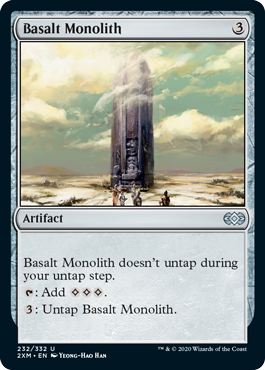
Double Down
That's all the time we have for today. I hope you enjoyed hearing my stories and seeing the previews. As always, I'm eager for your feedback, both on today's column and on the set in general. You can email me or contact me through any of my social media accounts (Twitter, Tumblr, Instagram, and TikTok).
Until next time, may you have twice the fun when playing Double Masters.
#759: Sheldon Menery
#759: Sheldon Menery
In this podcast, I talk with Sheldon Menery about his days of judging and his role in helping to create the Commander format.
#760: Shivam Bhatt
#760: Shivam Bhatt
30:12
In this podcast, I talk with Shivam Bhatt about his role with Commander and his podcast.
- Episode 758 Doug Beyer
- Episode 757 Brian Hacker
- Episode 756 Chris Pikula

